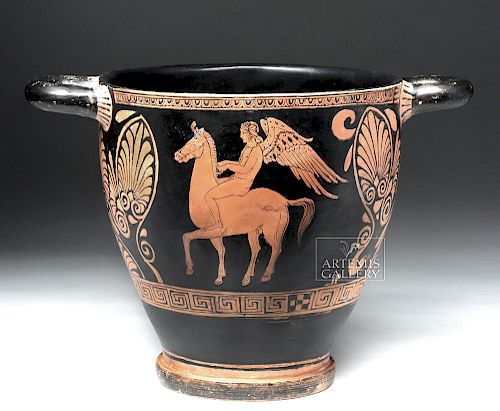Huge Apulian Skyphos - Eros on Horse, Satyr & Maenad
Lot 26
About Seller
Artemis Fine Arts
686 S Taylor Ave, Ste 106
Louisville, CO 80027
United States
Selling antiquities, ancient and ethnographic art online since 1993, Artemis Gallery specializes in Classical Antiquities (Egyptian, Greek, Roman, Near Eastern), Asian, Pre-Columbian, African / Tribal / Oceanographic art. Our extensive inventory includes pottery, stone, metal, wood, glass and textil...Read more
Categories
Estimate:
$12,000 - $16,000
Absentee vs Live bid
Two ways to bid:
- Leave a max absentee bid and the platform will bid on your behalf up to your maximum bid during the live auction.
- Bid live during the auction and your bids will be submitted real-time to the auctioneer.
Bid Increments
| Price | Bid Increment |
|---|---|
| $0 | $25 |
| $300 | $50 |
| $1,000 | $100 |
| $2,000 | $250 |
| $5,000 | $500 |
| $10,000 | $1,000 |
| $20,000 | $2,500 |
| $50,000 | $5,000 |
| $100,000 | $10,000 |
| $200,000 | $20,000 |
About Auction
By Artemis Fine Arts
Jun 20, 2018
Set Reminder
2018-06-20 10:00:00
2018-06-20 10:00:00
America/New_York
Bidsquare
Bidsquare : DAY 1 | Antiquities, Asian, Russian, Fine Art
https://www.bidsquare.com/auctions/artemis-gallery/day-1-antiquities-asian-russian-fine-art-3276
Day 1 of an important 2-day auction featuring exceptional art from around the world Artemis Fine Arts info@artemisfinearts.com
Day 1 of an important 2-day auction featuring exceptional art from around the world Artemis Fine Arts info@artemisfinearts.com
- Lot Description
Magna Graecia, Apulian, ca. 370 to 360 BCE. A very sizeable and attractive red-figure skyphos (wine cup), depicting (on Side A) a winged nude Eros in profile, riding a horse adorned by a petite dolphin brand on its buttocks, and (on Side B) a nude male satyr with characteristically pointy asinine ears, standing with legs crossed at the knees, his torso skewed toward the right, and his profiled head turned toward the left, carrying a cloak over his right arm while leaning against his pedum (shepherd's crook), and extending his left arm outward. Standing beside him is a female maenad nymph, dressed in flowing chiton and carrying a thyrsus (pine cone tipped staff) in one hand - all suggesting a Dionysian context. Beneath each handle is an intricately delineated ensemble of stylized palmettes; above the scenes is a narrow register ovalo, and below a somewhat wider meander band with three checkerboard and one "x" panel interspersed. Size: 16.25" W handlespan x 11" H (41.3 cm x 27.9 cm)
The dolphin brand on Eros' horse is quite interesting. Did you know that in ancient Greece, dolphins were beloved for their intelligence and giving nature. Dolphins were so highly revered that killing one was considered a crime punishable by death. Some argue that the dolphin is Greece's national animal. Indeed the dolphin's importance to ancient Greece has a deep history. Dolphins appear repeatedly in the murals adorning Minoan palaces, and Greek mythology includes many references to the dolphin. Eros is oftentimes depicted riding across the sea on the back of a dolphin - an image associated with Dionysian religion. On this skyphos, the artist presents a twist on this theme with Eros riding a horse that is cleverly branded with a dolphin.
One myth that associates dolphins with an altruistic nature and keen intelligence involves Dionysus, the god of wine and pleasure, transforming himself into a young mortal when sailing to the island of Naxos, so that he would not attract a great deal of attention to himself. However, on his journey, Dionysos overheard the crew discussing a scheme to sell him as a slave. Upset by this, Dionysos turned the oars into fearsome serpents, and the frightened sailors elected to jump overboard. Soon Poseidon felt sorry for the sailors and transformed them into dolphins. The god of the sea welcomed them to his kingdom and declared their mission to help all seamen in peril.
Provenance: private East Coast, USA collection
All items legal to buy/sell under U.S. Statute covering cultural patrimony Code 2600, CHAPTER 14, and are guaranteed to be as described or your money back.
A Certificate of Authenticity will accompany all winning bids.
We ship worldwide and handle all shipping in-house for your convenience.
#132476Professionally reassembled from numerous pieces.Condition
- Shipping Info
-
All shipping is handled in-house for your convenience. Your invoice from Artemis Gallery will include shipping calculation instructions. If in doubt, please inquire BEFORE bidding for estimated shipping costs for individual items.
-
- Buyer's Premium



 EUR
EUR CAD
CAD AUD
AUD GBP
GBP MXN
MXN HKD
HKD CNY
CNY MYR
MYR SEK
SEK SGD
SGD CHF
CHF THB
THB


















